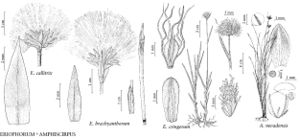Difference between revisions of "Eriophorum callitrix"
Mém. Acad. Imp. Sci. St.-Pétersbourg Divers Savans 1: 203, plate 2. 1831.
FNA>Volume Importer |
GeoffLevin (talk | contribs) m (Fixed italics in discussion) |
||
| (7 intermediate revisions by 2 users not shown) | |||
| Line 8: | Line 8: | ||
}} | }} | ||
|common_names=Linaigrette àbelle crinière | |common_names=Linaigrette àbelle crinière | ||
| + | |special_status={{Treatment/ID/Special_status | ||
| + | |code=F | ||
| + | |label=Illustrated | ||
| + | }} | ||
|basionyms= | |basionyms= | ||
|synonyms= | |synonyms= | ||
| Line 24: | Line 28: | ||
|elevation=0–2600 m | |elevation=0–2600 m | ||
|distribution=Greenland;Alta.;B.C.;Man.;Nfld. and Labr.;N.W.T.;Nunavut;Ont.;Que.;Sask.;Yukon;Alaska;Mont.;Wyo.;Eurasia. | |distribution=Greenland;Alta.;B.C.;Man.;Nfld. and Labr.;N.W.T.;Nunavut;Ont.;Que.;Sask.;Yukon;Alaska;Mont.;Wyo.;Eurasia. | ||
| − | |discussion=<p>Two varieties, Eriophorum callitrix var. moravium Raymond and E. callitrix var. pallidus Hultén, have been described based on the pale brown or yellow scales. They are of very local distribution and could be of hybrid origin.</p> | + | |discussion=<p>Two varieties, <i>Eriophorum callitrix</i> var. <i>moravium</i> Raymond and <i>E. callitrix</i> <i></i>var.<i> pallidus</i> Hultén, have been described based on the pale brown or yellow scales. They are of very local distribution and could be of hybrid origin.</p> |
|tables= | |tables= | ||
|references= | |references= | ||
| Line 33: | Line 37: | ||
-->{{#Taxon: | -->{{#Taxon: | ||
name=Eriophorum callitrix | name=Eriophorum callitrix | ||
| − | |||
|authority=Chamisso | |authority=Chamisso | ||
|rank=species | |rank=species | ||
| Line 47: | Line 50: | ||
|publication title=Mém. Acad. Imp. Sci. St.-Pétersbourg Divers Savans | |publication title=Mém. Acad. Imp. Sci. St.-Pétersbourg Divers Savans | ||
|publication year=1831 | |publication year=1831 | ||
| − | |special status= | + | |special status=Illustrated |
| − | |source xml=https:// | + | |source xml=https://bitbucket.org/aafc-mbb/fna-data-curation/src/2e0870ddd59836b60bcf96646a41e87ea5a5943a/coarse_grained_fna_xml/V23/V23_32.xml |
|genus=Eriophorum | |genus=Eriophorum | ||
|species=Eriophorum callitrix | |species=Eriophorum callitrix | ||
Latest revision as of 23:44, 2 December 2021
Plants cespitose. Culms 5–20(–50) cm, smooth or rough distally. Leaves: cauline leaves 0–1, distal leaf usually proximal to mid culm, bladeless or with short blade; blade forming angle with sheath, filiform or trigonous-channeled, 0.4–1.2 mm wide. Inflorescences: involucral bracts absent or present as short blade on distal leaf. Spikelets solitary, erect, globose in fruit, 10–20 mm in flower, 15–30 mm in fruit; scales pale blackish brown, margins and tip hyaline, ovate-lanceolate, thin; proximal empty scales mostly 10–15, appressed to ascending, ovate, 5–8 mm, ribs ± to margins, midrib not reaching tip, apex acute. Flowers: perianth bristles white to very pale brown; anthers 0.6–1.2 mm. Achenes ellipsoid-obovoid, 1.8–2.1 mm. 2n = 60.
Phenology: Fruiting summer.
Habitat: Tundra, calcareous bogs, wet places
Elevation: 0–2600 m
Distribution

Greenland, Alta., B.C., Man., Nfld. and Labr., N.W.T., Nunavut, Ont., Que., Sask., Yukon, Alaska, Mont., Wyo., Eurasia.
Discussion
Two varieties, Eriophorum callitrix var. moravium Raymond and E. callitrix var. pallidus Hultén, have been described based on the pale brown or yellow scales. They are of very local distribution and could be of hybrid origin.
Selected References
None.
